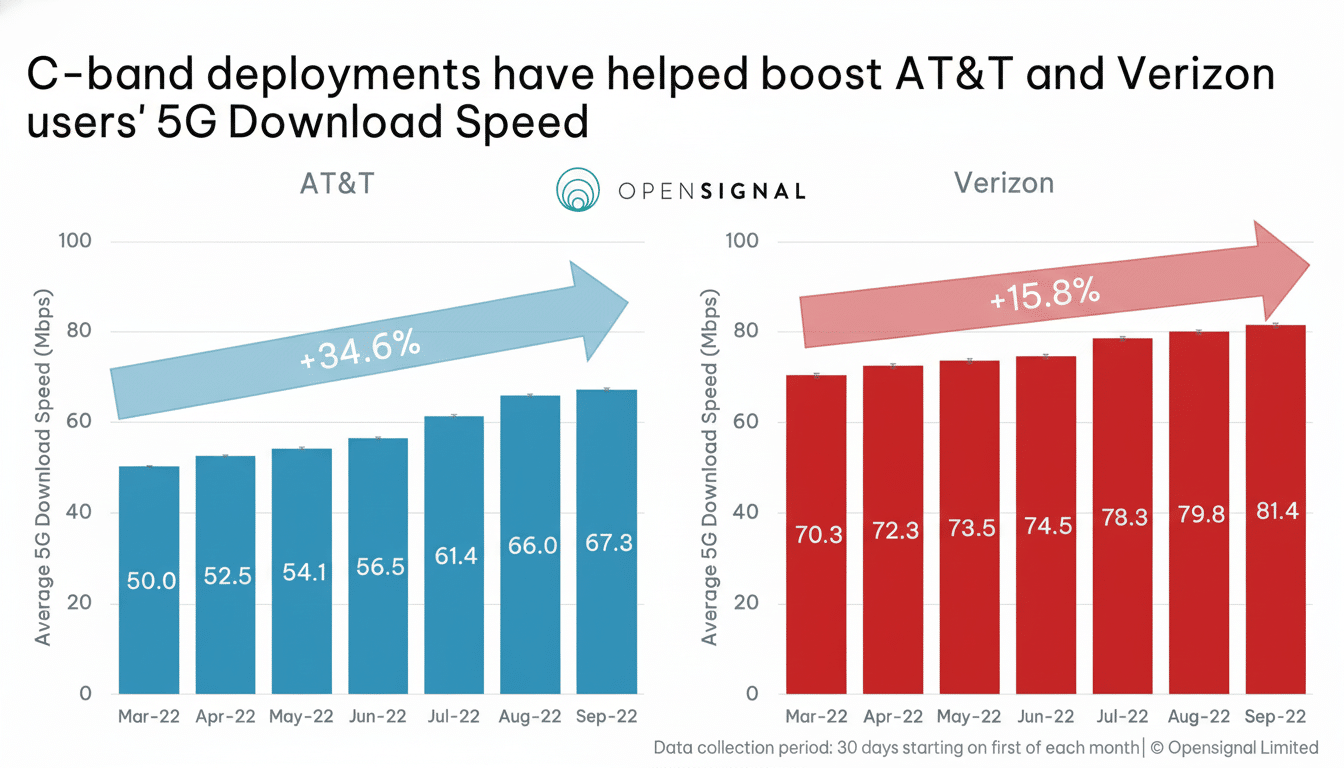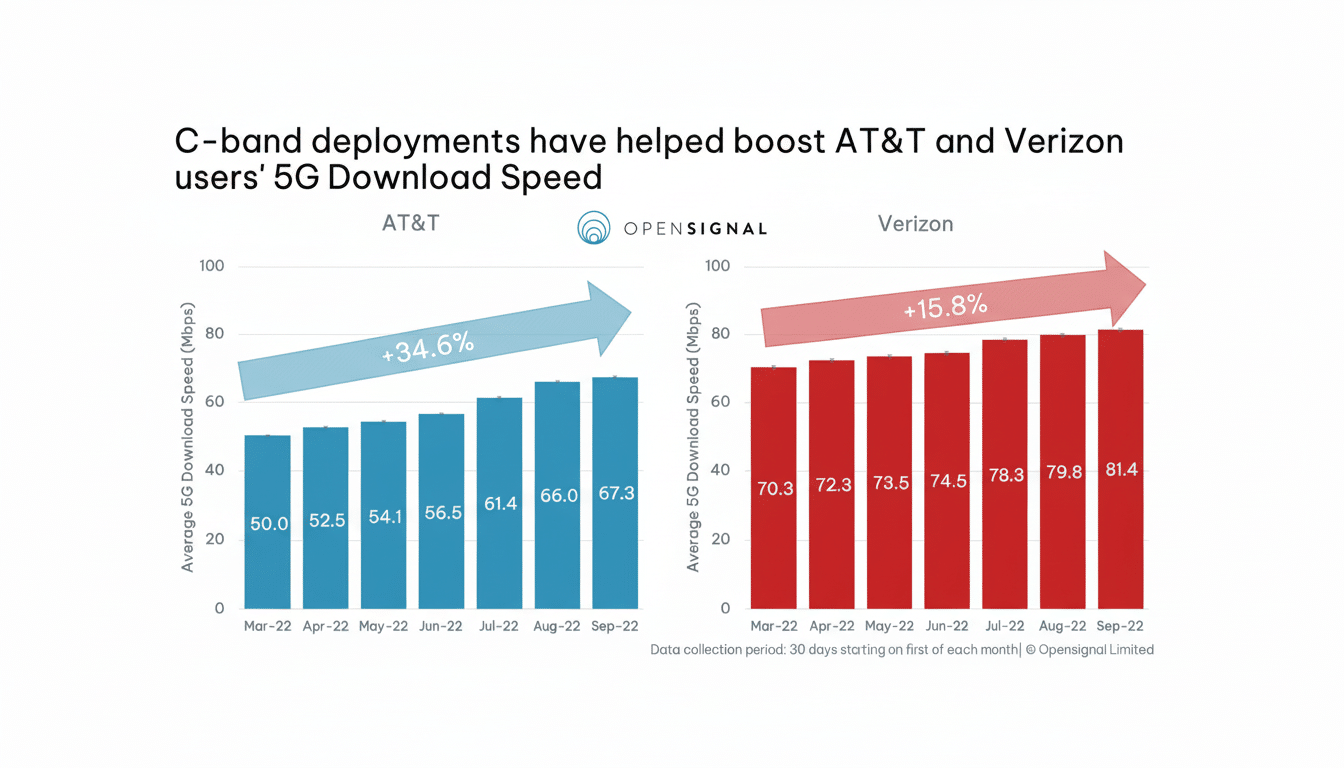AT&T has turned on a big mid-band 5G upgrade, adding new 3.45GHz spectrum it recently bought to nearly 23,000 cell sites and lighting it up in more than 5,300 cities in 48 states. The company claims that customers with devices that meet its standards will see download speeds that are up to 80% faster, and its 5G home internet service, Internet Air, is getting as much as a 55% boost — all without the need to fork over extra money.
What AT&T Switched On with New 3.45GHz Spectrum
The backbone of this build-out will be the 3.45GHz band, which is so-called mid-band spectrum with a combination of speed and coverage. AT&T recently bought these airwaves from EchoStar’s Boost Mobile/Dish portfolio, and has now integrated them into its existing 5G network. AT&T is combining its C-band spectrum with 3.45GHz and low-band to build bigger-block mid-band, which can be deployed for wider channels and carrier aggregation, thus achieving high peak speeds and sustained throughput.
- What AT&T Switched On with New 3.45GHz Spectrum
- Why Mid-Band Matters for 5G Speed and Coverage
- Where Customers Will See Benefits from Added Capacity
- How It Compares with the Competition in 5G Upgrades
- What You Need to Gain the Most from AT&T’s Upgrade
- The Technical Angle: Spectrum, Channels, and Capacity
- What Comes Next for AT&T’s Mid-Band 5G Expansion

Put in simpler terms, this allows AT&T to devote more spectrum to 5G at any one time, giving phones and home gateways a wider data pathway on which to move. It’s within 3GPP band n77, which most newer devices already support, so there’s no bottleneck to adoption.
Why Mid-Band Matters for 5G Speed and Coverage
Mid-band is the Goldilocks of 5G — low-band goes far, but can feel slow; millimeter wave blisters quickly, but has trouble going through buildings or any kind of tree leaf. Mid-band is a better mix of the two. Independent reports from firms including Opensignal and Ookla have consistently demonstrated that well-built mid-band deployments can provide several hundred megabits per second in real-world conditions, farther than high bands indoors.
By beefing up its mid-band layer, AT&T is increasing capacity as well as speed. This translates into faster downloads whenever you’re sitting near a site, and more consistent throughput during rush hours when a lot of users are attempting to connect.
Where Customers Will See Benefits from Added Capacity
The upgrade spans teeming cities and fast-growing suburbs — regions where gridlock has traditionally stalled speeds. Sports stadiums, shopping districts, business corridors and residential areas under the new spectrum should feel smoother streaming, snappier app updates and shorter upload times for photos and videos.
First responders on FirstNet — AT&T’s dedicated public safety network — benefit as well, as enhanced capacity and mid-band coverage bolster performance for prioritized traffic during large events and high-traffic emergencies.
How It Compares with the Competition in 5G Upgrades
T-Mobile was first out of the gate with its 2.5GHz mid-band swath, and then Verizon sped up after lighting up C-band. AT&T has earned high marks for reliability and fell just behind in raw download speed in analyses from Opensignal, Ookla and RootMetrics. This 3.45GHz addition adds to the mid-band depth, which AT&T can leverage more than higher-spectrum averages, since deeper mid-band layers let it lift overall averages while also boosting speeds in slowed-down markets.
If AT&T can pair this spectrum with further densification and advanced carrier aggregation, you can bet that its performance rankings in future industry reports will look a lot tighter.

What You Need to Gain the Most from AT&T’s Upgrade
Most of the latest 5G phones work on band n77, including the following:
- iPhone 13 and later
- Samsung Galaxy S21 and later
- Google Pixel 6 and newer
Ensure 5G is enabled in settings, install the latest software, and look for “5G” or “5G+” indicators. Customers located in Internet Air areas should notice improved speeds when the expanded mid-band footprint lights up at their addresses.
Companies harnessing 5G to deliver point-of-sale systems, video collaboration or field connectivity may also experience fewer bottlenecks, particularly in tight corridors during weekends or the commute.
The Technical Angle: Spectrum, Channels, and Capacity
Mid-band performance depends on the channel width and aggregation. With 3.45GHz under the larger n77 umbrella, paired with C-band, AT&T can light up a wider effective channel to deliver higher peak rates and sustain those speeds as more users connect. In cases where one is available, a 5G standalone core further cuts control-plane overhead and may help trim any latency bloat, for greater consistency with gaming and cloud apps.
The immediate win is capacity: more spectrum per site means less fighting over it. That means more consistent performance in apartment-dense neighborhoods and crowded venues where speeds used to fluctuate wildly.
What Comes Next for AT&T’s Mid-Band 5G Expansion
There’ll be more mid-band, bolder carrier aggregation combinations, and gradual refinements as the software on towers and devices gets better. With no price bump attached to this upgrade, AT&T is clearly betting that a noticeable improvement in everyday speeds — and more resilience at peak times — will make an impression on both mobile and home internet customers.
The key takeaway for consumers is straightforward: if you have a recent 5G device, you are probably going to feel the effect. And the competitive calculus just got more interesting for the race to 5G in the United States.

